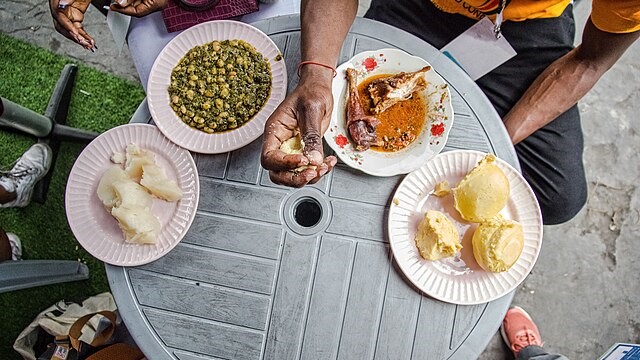On the streets of Pointe-Noire, the Republic of the Congo’s bustling port city, the scent of wood smoke and sizzling spices carries on the ocean breeze. Markets spill into the sidewalks, their stalls crowded with banana-leaf parcels, trays of skewered meats, and baskets of fresh produce. The air is thick with sound: vendors calling out daily specials, the crackle of open grills, and the low hum of traffic rolling past.
Banana leaves serve as both wrapping and signature—part of a long-standing culinary tradition. Their subtle, grassy aroma infuses food during cooking, while their pliable surface keeps grilled fish and steaming stews intact. At one stall, a fish, marinated in ground spices and a touch of citrus, is folded neatly into its leaf, edges sealed by the heat of the coals. A few steps away, a pot of stew simmers slowly, its surface dotted with red oil and fragrant with ginger.
Spice defines Pointe-Noire’s street fare as much as technique. Black pepper, garlic, and ginger appear again and again, layered into dishes for both depth and brightness. Among the staples is saka-saka—cassava leaves pounded, stewed with ground peanuts, and often enriched with smoked fish. Paired with rice or fufu, the dish offers a balance of earthiness and savor, a taste both humble and emblematic of the region.
Along Boulevard de la République, the rhythm changes. Vendors turn skewers of meat over glowing embers, the fat hissing as it meets the flames. These brochettes, seasoned simply but decisively, are served with tangy sauces that cut through their richness. Glasses of fresh juice—mango, guava, or passion fruit—cool the palate, while the air remains laced with the scent of charcoal and spice.
Down by the fishermen’s markets, the day’s catch comes ashore: barracuda, snapper, and smaller coastal fish, their scales glinting in the late-afternoon light. Some are grilled whole, brushed with chili paste and garnished with chopped herbs; others are served alongside manioc or fried plantains. Here, freshness is not an aspiration but a given, dictated by the tides and the morning’s labor.
The street food culture of Pointe-Noire is more than a collection of recipes. It is a living record of trade routes and migration patterns, of local ingenuity shaped by geography and history. It thrives in the interplay of flavors, the informality of the stalls, and the shared experience of eating in public spaces. Each dish carries a fragment of the city’s identity—rooted in tradition, open to adaptation, and seasoned with the warmth of communal exchange.
Sources:
- Republic of the Congo Ministry of Tourism. Culinary Traditions of Pointe-Noire. Updated 2025.
- N’Kanza, Jacques. “Street Food and Cultural Identity in Coastal Congo.” African Culinary Review, vol. 8, no. 2, 2024.
- Food and Agriculture Organization (FAO). Cassava and Coastal Food Practices in Central Africa. 2023.

